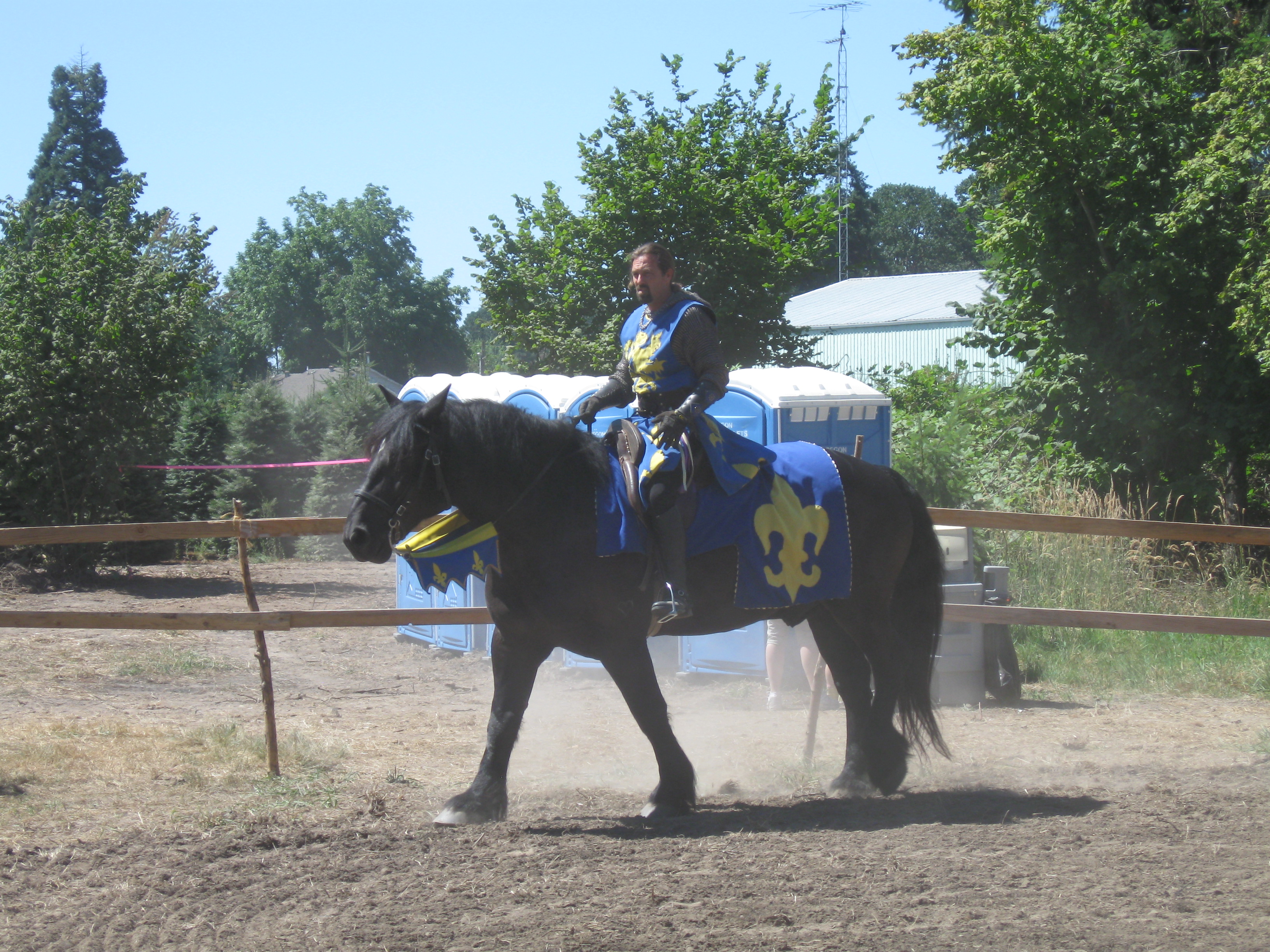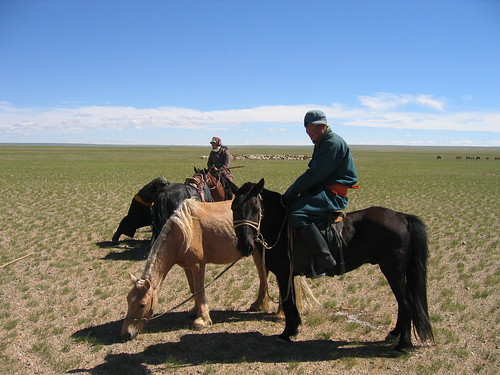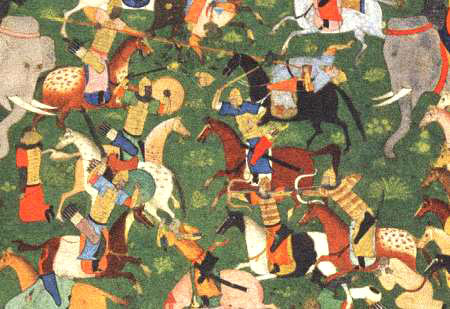It can be a difficult road for those of us who are both avid consumers of spec fic and also knowledgeable about certain elements of such genres.
Nothing is as ubiquitous to portrayal of the pre-modern lifestyle than the horse. And no other creature is as abused through sloppy research and lazy writing.
The worse transgressors are, of course, screenwriters, then novelists (especailly those using the Tolkein Play Book(TM)). And I suspect if you took a random sampling of horse art in comics, there wouldn't be an accurately drawn bit of tack in the entire lot. I'll give video game creators a lot of forgiveness due to playability issues with a realistic horse (constantly losing your mount every time you dismount to fight a forest spider would get old real fast). But novelists, now, you have no excuses. You're already researching stuff. That's what the internet is for.
I really appreciate the blog "Science in my Fiction", but they severely lack in the domestic animal category.
Let's talk a little about horses, shall we.
Horses are not dogs
I think this is the basic problem with unrealistic depictions of most fictional animals. Your average writer is a lot more likely to own or have available a dog than a horse. Therefore are a lot more familar with dogs than with horses, and instinctively (or purposefully) extrapolate traits from one animal to another. Humans in general share more similar social structure, diet and ways of communicating with dogs than we do with horses. We also have associated much longer; dogs about 30,000 years, horses at most 9,000.
So let's get this out of the way first: Unless specially trained (or magical) a horse:
1) won't come when called
2) won't stay put unless tied
3) won't fetch your slippers (or your sword)
4) won't guard your house/camp/village, and won't call an alarm either, if it can run away instead
5) won't fight by your side if you're unseated during a battle
6) don't want to be your friend. They may like you, but they want to be with other horses more (sorry to break it to you, 12-year-old me and also pretty much every 12-year-old girl everywhere ever)
While there can certainly be affection and mutual trust between horse and human, loyalty is not a default horse setting. And most simply don't have the capacity to follow commands once the human is out of sight. You want these traits in your fictional horses? Use some world building, please. A single sentence like "...the Wallyhoo war horses, specially bred for a thousand years by the magical wizards of the Great Plateau, would gladly <insert non-horsey trait here>" is all it takes.
A scared horse is a quiet horse
Real horses are a lot quieter than their fictional counterparts. Most of their communication is body language. They may whinny and nicker as a greeting, but they may simply sniff and nuzzle each other. They may shout a distressed call to their friends if they're left alone, or they may simply stare with concern. An angry horse may squeal, or make this growling screamy noise, but usually even the most violent of horse fights are silent except for the scuffling of feet and the occasional grunt.
A horse who is scared but accessing the situation will often snort, like this. On rare occasions of extreme terror and imminent pain and/or death, a horse will scream. But a horse who thinks they're facing an unknown predator (i.e. anything new including shadows), is not going to "whinny in fear" or make a bunch of commotion to attrack that predator's attention. They're going to be quiet until they deem it necessary to run away. After that, the only commotion will be them fighting their rider/traces/pack saddle if it interferes with their escape.
Horses don't care about blood
If I had a nickel for every fantasy novel containing the equivalent of "...the horses went wild at the scent of blood", I'd have enough to make, like, a big coin mural or something.
Unless it's the blood of a herdmate, or a battle-hardened horse who's been taught to associate the smell of blood with fear/pain/excitement, your average horse could give two figs about another creature's blood.
At least once a year, my family skins and cleans deer elk and/or sheep in the same barn where the the horse stalls are. Do you know what the horses do as we fill buckets with blood and viscera five yards away from their faces? Watch with placid indifference. They had the option of running out into the pasture, but they never did. I once brought them my blood covered hands to smell. They sniffed with academic interest, probably just to make sure there wasn't a treat they were missing.
Horses don't need to be big
The irony of ren faires (though I love them dearly) is that the lowly equines of the kids' pony ride look more like actual historic war horses than the ones used in the "re-enactment" shows.
A beast as large as the one pictured below probably didn't exist anywhere in the world until the late 18th century.
For millinea, horses have been getting the job done while being under 15hh. Yet, everywhere you look, in fiction and non-fiction re-enactments, you see modern-looking, giant horses doing everything, from pulling a plow to carrying a soldier into battle. It's downright insulting to horsekind to say that only those over a certain size can do any real work.
The average sized horse in 14th century Britain was 12-14 hands; Ghengis Khan's army of horses were all about 13 hh. The best bred horses in the ancient Greek armies averaged 13.2-14.2hh (including the famously "massive" Bucephalus).
Here's a couple of photos to get a feel for what 12-14 hh looks like. Keep in mind also that people in the middle ages were not much shorter than today.
Can you imagine a 12hh pony like this being in a cavalry charge? They were!
Compare it to this illustration of a Mughal nobleman (c. 1660) on what was probably considered a fine, large war horse (and is likely is under 15hh).
The riders on the Bayeux Tapestry have their feet dangling well below the girth (common in a lot of old horse art you'll notice), indicating the horses they're riding are quite small indeed.
We'd probably call it animal cruelty today if this This 13.2 hh pony were loaded with a grown man plus armor and weapons. But for the majority of history, this would have been considered a fine horse for a rich guy to ride in a battle: muscular, good bone, good hip, and short coupled back. It's our modern imagining of a destrier in miniature - except it wouldn't have been considered "miniature".
Farm horses didn't look like this:
They looked like this:
For an idea of how normal small size was up until recently, consider the law passed in England in 1540 CE. In order to improve the size of English horses, it became illegal to breed stallions if they were smaller than 15hh. Mares had been set an even lower bar, and could be bred as long as they were at least 13hh. A couple of decades later, Queen Elizabeth partially repealed this law because she was afraid horses would get so big and heavy that they'd sink in the English mud and become mired.
If you want to see what real horses were like, don't look to ren faires or movies or reenactments - look to Mongolia. The horses there have changed little over the last couple thousand years. They're still small, hardy, survive on little forage, and are expected to carry full grown adults and supplies over long distances.
http://www.flickr.com/photos/tiarescott/33317871/
Stallion myths
Even the average horse-savvy person, if asked about stallions, will likely spout at least one myth, that's how much knowledge we've lost since gelding became common. There's a good summary of common myths here.
Basically: stallions should be treated just like any other horse. Stallions aren't super special alien beings. In many countries where castration isn't common, stallions work alongside other stallion and geldings and mares often.
Also note: historically, mares were ridden into battle at least as often as stallions.
Know your gaits
On the whole, I'm not a terminology nazi. However, trot, canter, and gallop are not interchangeable. Also, they are not the only gaits that exist. There is this thing called pacing (see also: amble, tolt, rack, run-walk) that is very important to know about if your fiction world doesn't have good roads and carriages with advanced suspension. It's not as popular now, but historically a horse who was able to pace was more common than not in Europe. Riding long distances is easier because it's smoother than a trot, but about as fast.
Your character did not "gallop all night", because even the best horse, unless aided by magic, can't sprint for hours without rest. If you want to fudge and say "he ran all night", fine. But most likely, if you're traveling any distance on horseback, you're going to spend most of it at a trot (about 7 mph) (or, as discussed above, an amble or running walk, which is about the same speed). A healthy, conditioned horse being ridden by a human who is desperate to get somewhere far away and willing to risk her steed's health to get there, could probably goad a horse to trot or canter faster: say, 10mph, for many hours before the horse collapsed or slowed.
Don't be afraid of spots
Bay, chestnut, black and grey are not the only colors horses came in. Horses of historical Europe come in all colors, spotted and paint included.
Don't be afraid to give your knight a spotted charger to ride.
"Breed" belongs in scare quotes
Up until very recently, as with all other domestic animals, horses were selectively bred and catagorized by type or use, not by "pure breeding". In the past you didn't refer to a horse by breed, but by its type, or perhaps the region or name of the stable it came from.
If you're creating a world based on pre-Victorian society, throw out your ingrained notions of "pure blood", and closed studbooks. Ignore the outdated but still widely published idea of "four original horse types". It is rubbish. Actual science tells us that all horses come from mixed ancestry of one kind or another. All of them. None are "pure". There is no such thing as an "unbroken line", (except in the sense that all horses have both a mother and father). For the love of all that is good and holy, do not read the "breed history" pages on breeders' or breed club websites. They are full of romantic lies and fairy tails. Gypsy Vanners did not pull the wagons of the Roma people. You may as well claim that the Chinese rode Appaloosas because there are ancient paintings of spotted horses in Asia.
Yes, there have been domestic horses on the Arabian peninsula for thousands of years, probably being selectively bred for much of that time. That doesn't mean that the Arabian horse "breed" has existed for that long, nor remained "pure" in the modern sense of the word.
Heck, even "selective breeding" doesn't mean the same. For most cultures for most of history, "selective" breeding means something like this: you let all your horses co mingle in the same pasture, probably open and shared with neighbors. They breed more-or-less like wild horses, stallions competing each other for mares. You wander out once a year and pick the best looking youngsters and bring them into the stable (or corral, or tie near your tent/hut) to be trained. Being the best-fed, these favorites end up breeding more often than others, but it's never exclusive. You occasionally cull ones you don't like, but mostly you just ignore them and nature kills them off, or they simply can't compete, or don't feel like mating.
If your horses are better in some way from your neighbor, they'll buy from you to improve their own stock, which in turn end up being sold down the road, or are lost or captured or run off during battle to become breeding stock for someone a continent away. Sometimes you buy a good looking mare you saw at the fair, or come across a wild band of horses and like the look of the stallion so you capture it.
Sometimes whole lineages are lost due to war or disease or famine or accident, but a few hundred years later, by accident or design, a very similar type is created somewhere else by someone completely different.
No closed studbooks; no castration (or rarely); no hyper-control over bloodlines; no extreme isolation stallions or mares. Mix-and-match was the order of the day, and this method produced fine animals for thousands of years.
Writers deserving of special mention
Anne McCaffery - knows horses in her bones, owned them while she was writing them into her stories. Black Horses for the King opened my eyes to many of the issues above.
Mercedes Lackey - excellent examples of how to world-build the creatures you want in a logical way. You want horses that act like dogs? Explanation! And then move on. Thank you.
The creators of Skyrim - get points for having horses that will totally run away and leave your ass stranded if there's something attacking them.
If you have suggestions of others (the good or the terribly bad) please leave them in the comments.










5 comments:
Interesting observation: Native Americans had no word for horse, so they called them either dogs or deer.
I spent a lot of time over the years hanging out with horses. They are at a much lower level of domestication than dogs, and I've known only a few that really liked people. I knew one ol' dappled gray mare that would run me down and demand a good scratch before she'd let me go, but virtually all the other ones would only come if I had an apple or two.
They do not respond to pointing with an index finger the way dogs do!
I cannot express how much I love this! I've been trying to explain every one of these to my (academic) colleagues for years! I can almost accept it in fiction (ok, not really, but I can sigh and try another book), but I was absolutely shocked to find that these myths are still perpetuated by scholars.
NewLeaf - the ones that bother me the most are the ones about breed history and breeding practices. The "four original types" idea is so utterly wrong and yet so widespread, and reality is so much more cool and interesting!
My favorite was when my daughter burst out laughing while reading. I asked what's so funny? She said, well someone poisoned the horses and they're "vomiting" some neon green stuff. I said horses can't vomit, she said yes, well obviously the author does not know that. :)
Post a Comment